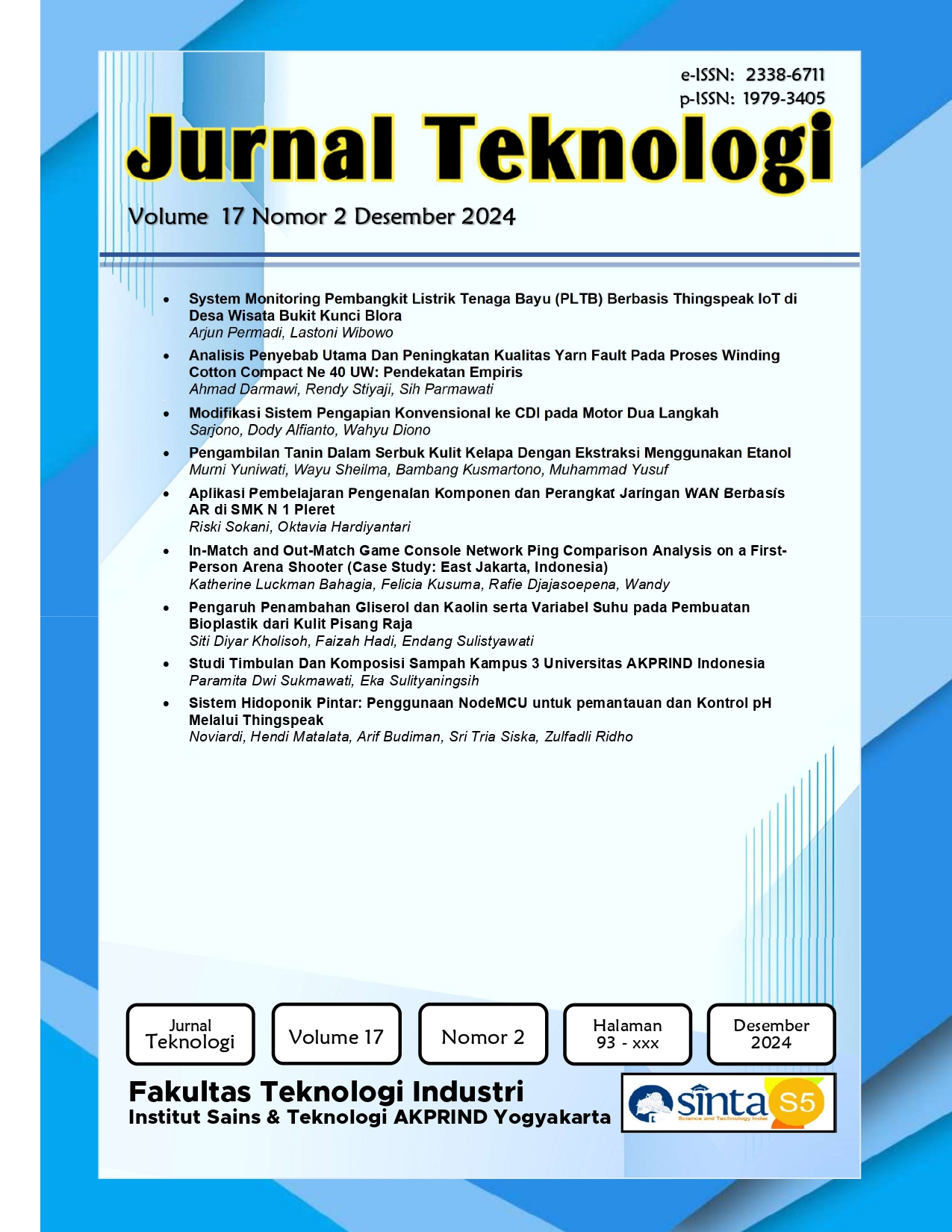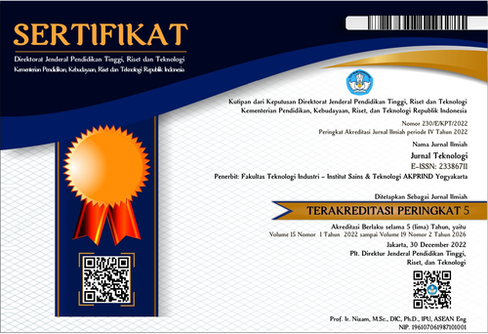Analisis Penyebab Utama Dan Peningkatan Kualitas Yarn Fault Pada Proses Winding Cotton Compact Ne 40 UW: Pendekatan Empiris
DOI:
https://doi.org/10.34151/jurtek.v17i2.4412Keywords:
cotton compact, quality improvement, winding process, yarn defectsAbstract
This study aims to identify and analyze the main factors contributing to the high yarn fault rates in the winding process of Cotton Compact Ne 40 UW production at PT Tantra Textile Industry. The methodology employed includes an ex post facto approach, direct observation, and historical data analysis from the Ring Spinning Frame (RSF) and winding machines. The findings reveal that Short Thick and Long Thick faults are the most dominant types, accounting for over 60% of the total detected faults, primarily due to variations in yarn thickness beyond control limits. Additionally, unstable environmental conditions and suboptimal machine cleanliness were found to exacerbate the quality of the yarn. These findings emphasize the need for stricter control over environmental parameters and improved machine maintenance to enhance yarn quality. The practical implications of this research include the implementation of advanced environmental monitoring systems and intensive machine maintenance programs. This study makes a significant contribution to the literature by providing detailed empirical analysis of the factors affecting yarn quality during the winding stage and offering data-driven recommendations for improving textile production quality.
Downloads
References
Adamu, B. F., Atalie, D., & Liyew, E. Z. (2021). Quality Evaluation of Ethiopian 100% Cotton Carded Ring Spun Yarn with Respect to USTER Standards. Journal of Engineering, 2021, 1–9. https://doi.org/10.1155/2021/4286957
Afshar, M., Abdi, S., Oraee, A., Ebrahimi, M., & McMahon, R. (2021). Eccentricity fault detection in brushless doubly fed induction machines. IET Electric Power Applications, 15(7), 916–930. https://doi.org/10.1049/elp2.12060
Ahmed, T., Toki, G. F. I., Mia, R., Li, J., Islam, S. R., & Rishad, M. M. A. (2022). Implementation of the Six Sigma Methodology for Reducing Fabric Defects on the Knitting Production Floor: A Sustainable Approach for Knitting Industry. Textile & Leather Review, 5, 223–239. https://doi.org/10.31881/TLR.2022.29
Ali, M. H., Ahmed, R., & Amer, M. (2021). Yarn Tension Control Technique for Improving Polyester Soft Winding Process. Scientific Reports. https://doi.org/10.1038/s41598-020-79928-1
Amanuel, L. (2021). Woven fabric defect control methods in shuttle loom. Journal of Engineered Fibers and Fabrics, 16, 15589250211014181. https://doi.org/10.1177/15589250211014181
Barbu, I., Szabo, M., & Fogorasi, M. S. (2018). The high quality yarns – the first condition for quality textiles. IOP Conference Series: Materials Science and Engineering, 400, 062004. https://doi.org/10.1088/1757-899X/400/6/062004
Baymuratov, B., Tulanov, S., Sultanov, K., & Ismailova, S. (2021). Strain characteristics of cotton yarns depending on the strain rate and methods of their manufacture. E3S Web of Conferences, 304, 03027. https://doi.org/10.1051/e3sconf/202130403027
Devi, T. K., Mohan, M., Baluprithviraj, K. N., Poojashri, V., Swetha, A., & Vasuki, P. (2022). IOT Based Moisture Measurement and Conveyor Belt Monitoring in Yarn Mill. Journal of Physics Conference Series. https://doi.org/10.1088/1742-6596/2325/1/012009
Sayed, E. R., & Abd-Elkawe, E. Y. (2021). Production of Fine Count Yarns from Some Extra-long Egyptian Cottons on Different Spinning Systems. European Journal of Agriculture and Food Sciences, 3(5), 90–96. https://doi.org/10.24018/ejfood.2021.3.5.374
Erbil, Y., Islam, R., Babaarslan, O., & Sırlıbaş, S. (2022). Effect of Structural Changes on the Cotton Composite Yarn Properties. Journal of Natural Fibers, 19(5), 1899–1907. https://doi.org/10.1080/15440478.2020.1788687
Hossain, A. (2019). Uster Imperfections of 35% Cotton and 65% Polyester Blended Yarn for 40Ne, 50Ne and 60Ne Ring Spun Yarn. 1.
Ibrahim, I. (2018). Effect of Fiber Length and Short Fiber Percent in Cotton on Fiber and Yarn Quality. Alexandria Science Exchange Journal, 39 (October-December), 663–668. https://doi.org/10.21608/asejaiqjsae.2018.20692
Islam, M. I & Uddin, A. J. (2022). Enhancing the quality of elastane-cotton core yarn by compact spinning. Heliyon, 8(6). https://doi.org/10.1016/j.heliyon.2022.e09562
Islam, S., Parvin, F., Urmy, Z., Ahmed, S., Arifuzzaman, M., Yasmin, J., & Islam, F. (2020). A Study On The Human Health Benefits, Human Comfort Properties And Ecological Influences Of Natural Sustainable Textile Fibers. European Journal of Physiotherapy and Rehabilitation Studies, 1(1). Retrieved from https://oapub.org/hlt/index.php/EJPRS/article/view/47
Kanon, T. A., Rashid, M. E., Haque, R. U., Islam, M. A., & Khan, M. R. (2023). Double air suctioned carding process: A method for achieving improved quality ring-spun carded yarn. Heliyon, 9(1). https://doi.org/10.1016/j.heliyon.2023.e13096
Khan, Md. R., Dip, T. M., Rashid, Md. E., Haque, R. U., Neloy, F. K., Salehin, S. M. M., Sayem, A. S. M. (2023). Comparative Analysis of Production Processes and Quality Parameters of Two Different Semi-Combed Yarns. Journal of Natural Fibers, 20(1), 2163333. https://doi.org/10.1080/15440478.2022.2163333
Khodjiev, M., Abbazov, I., & Karimov, J. (2021). Influence of Local Resistance on Pressure and Speed Changes in Expanded Pneumatic Conveying. E3S Web of Conferences, 304, 03016. https://doi.org/10.1051/e3sconf/202130403016
Liyew, E. Z. (2022). Effect of the Imperfection of Open-End Yarn (Thin, Thick, and Nep Place) on Air Permeability of Plain Woven Fabric. Journal of Engineering, 2022(1), 8710495. https://doi.org/10.1155/2022/8710495
Mahawan, B & Luo, Z.-H. (2001). High-speed high-precision tracking control for electronically controlled winding machines. Control Engineering Practice, 9(5), 563–571. https://doi.org/10.1016/S0967-0661(01)00011-9
Nurwulan, N. R & Veronica, W. A. (2020). Implementation of Failure Mode and Effect Analysis and Fault Tree Analysis in Paper Mill: A Case Study. Jurnal Rekayasa Sistem Industri, 9(3), 171–176. https://doi.org/10.26593/jrsi.v9i3.4059.171-176
Pietrzak, P. (2024). Condition Monitoring and Fault Diagnosis of Permanent Magnet Synchronous Motor Stator Winding Using the Continuous Wavelet Transform and Machine Learning. Power Electronics and Drives. https://doi.org/10.2478/pead-2024-0007
Pradana, D. P., Rahayuningsih, S., & Santoso, H. B. (2020). Analisis Rejected Produk Dalam Proses Return Di PT. Gunawan Fajar Menggunakan Metode FMEA. JURMATIS (Jurnal Manajemen Teknologi Dan Teknik Industri), 2(1), 44–53.
Raian, S., Akter, S., & Baral, L. M. (2023). Prioritizing the quality parameters of cotton carded knit yarn by varying tensions of the bottom aprons of the ring frame. Textile & Leather Review, 6, 284–305. https://doi.org/10.31881/TLR.2023.046
Rashid, E., Haque, R. U., & Khan, R. (2021). Compact Spinning in Cotton-based Core-spun Yarn: A Review. European Scientific Journal, ESJ, 17(37), 287–287. https://doi.org/10.19044/esj.2021.v17n37p287
Riyadi, S., Haryadi, G. D., Suprihanto, A., Widodo, A., Ananto, G. P., & Kim, S. J. (2020). Failure consequences and risk based framework for reliability acceptance of the yarn winding machine. 060002. Jakarta, Indonesia. https://doi.org/10.1063/5.0015859
Roy, M. D., Ghosh, S., & Sivasamy, S. (2022). Study on the Frictional Behavior of Cotton Spun Yarn (Unraveled from Fabrics) after Different Wet Processing Stages. Journal of Natural Fibers, 19(13), 5008–5018. https://doi.org/10.1080/15440478.2021.1875349
Saha, S., Hossen, J., & Anm, M. R. (2020). Effect of Blend Ratio on Cotton-Modal Fibre Blended Ring- Spun Yarn Quality With Varying Modal Fibre Percentage. J Textile Sci Eng. https://doi.org/10.37421/jtese.2020.10.406
Yang, S & Gordon, S. (2018). 4—Fiber-to-yarn predictions. In M. Miao & J. H. Xin (Eds.), Engineering of High-Performance Textiles (pp. 81–106). Woodhead Publishing. https://doi.org/10.1016/B978-0-08-101273-4.00005-6
Downloads
Published
How to Cite
Issue
Section
License
Copyright (c) 2024 Ahmad Darmawi, Rendy Stiyaji, Sih Parmawati

This work is licensed under a Creative Commons Attribution-ShareAlike 4.0 International License.
Jurnal Teknologi provides immediate open access to its content in order of making research freely available to the public to support a global exchange of knowledge. All articles published in this journal are free for everyone to read and download, under licence CC BY SA.
Benefits of open access for the author, include:
- Free access for all users worldwide.
- Authors retain copyright to their work.
- Increased visibility and readership.
- No spatial constraints.




















